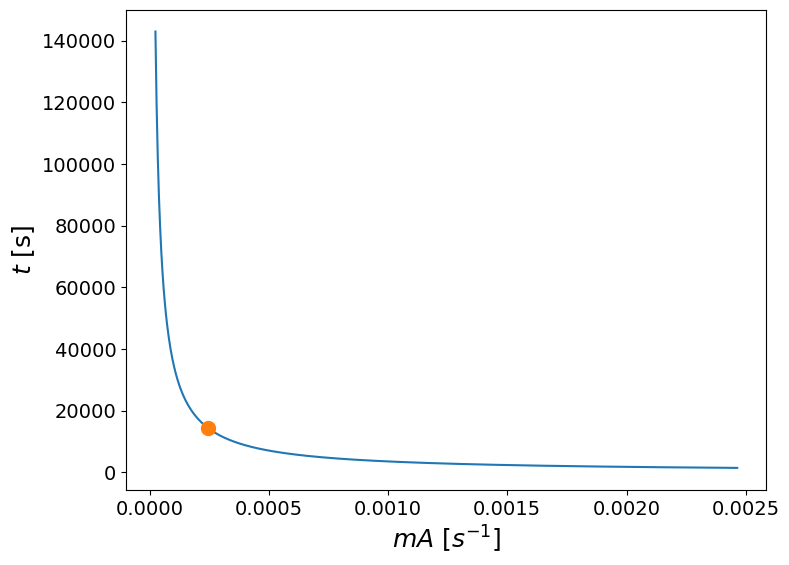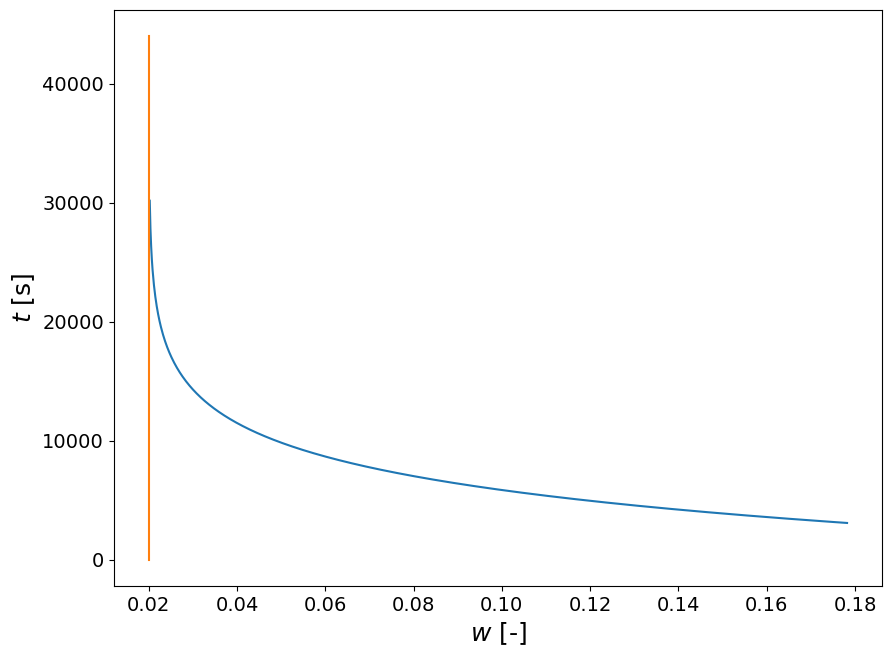Week 10 - Exercise#
Problem Statement#
Consider a drying process evolving through two stages of i constant drying rate, and ii falling rate (first order kinetics).
During stage i the drying rate per unit area is constant, and indicated with \(R_c=m\times{f_c}=const\).
Where:
\(m\) is a drying rate constant
\(f_c=w_c-w_e\)
\(w_c\) is the critical moisture content
\(w_e\) is the equilibrium moisture content
\(w_0\) is the initial moisture content
During stage ii the rate of drying is proportional to the free moisture content (\(f=w-w_e\)). The falling rate regime stops at the rquilibrium moisture content \(w_e\).
Tasks#
Derive an expression for the time necessary to reduce the moisture content from \(w_0\) to \(w_c\).
Derive an expression for the time necessary to reduce the moisture content from \(w_c\) to \(w_e\) in the (linear) falling regime.
Derive an expression for the time necessary to reduce the moisture content from \(w_0\) to \(w_e<w<w_c\).
If a system, characterised by critical moisture content of 18% and an equilibrium moisture content of 2% takes 7300 seconds to reach a final moisture content of 5% from an initial moisture content of 20%, how long will it take, in the same conditions, to dry a system from 30% to 3%.
For the same system produce a plot of the drying time as a function of the kinetic constant m.
Solution#
Task 1.#
In order to derive an expression for the time necessary to obtain a reduction in the moisture content from an initial value \(w_0\) to the critical moisture content \(w_c\) we shall start by realising that for \(w\geq{w_c}\) the rate of drying (per unit area) \(R=const=R_c=m(w_c-w_e)\).
Hence we can write the rate of reduction in moisture content \(\frac{dw}{dt}\) as:
which can be solved by separating the variables
and integrating:
leads to:
Task 2.#
In order to derive an expression for the time necessary to obtain a reduction in the moisture content from the critical value \(w_c\) to the equilibrium moisture content let us begin first by deriving an expression for a generic \(w_e\geq{w}<w_c\). In this case we know that the rate is linearly dependent on \(w\) accordig to the expression given in the text \(R=m(w-w_e)\). The rate of reduction in moisture content \(\frac{dw}{dt}\) now becomes:
which can be solved again by separating the variables
and integrating:
leads to:
we note that since \({w-w_e}\) is at the denominator,
so for the moisture content approaching iuts equilibrium value the time necessary diverges.
Task 3.#
The total time necessary to dry from an initial moiusture content \(w_0>w_c\) to a final moisture content \(w<w_c\) is equal to:
Task 4.#
Using the expression derived earlier one can compute first
and then once \(mA\) is known,
import numpy as np
w_e=0.02
w_c=0.18
w0_1=0.2
w_1=0.05
t_1=7300
mA=(1/t_1)*((w0_1-w_c)/(w_c-w_e)+np.log((w_c-w_e)/(w_1-w_e)))
w0_2 = 0.3
w_2 = 0.03
t_2=(1/mA)*((w0_2-w_c)/(w_c-w_e)+np.log((w_c-w_e)/(w_2-w_e)))
print("\nThe drying time is", f"{t_2:.4}", "[s]")
The drying time is 1.429e+04 [s]
Task 5.#
One cannot plot the dependence of the time on m alone, but the term mA can be used instead.
import numpy as np
import matplotlib.pyplot as plt
# Data
N=1000
mA_v = np.linspace(mA/10,10*mA, N)
t_v=(1/mA_v)*((w0_2-w_c)/(w_c-w_e)+np.log((w_c-w_e)/(w_2-w_e)))
#Plotting
figure=plt.figure()
axes = figure.add_axes([0.1,0.1,1,1])
plt.xticks(fontsize=14)
plt.yticks(fontsize=14)
axes.plot(mA_v,t_v, marker=' ')
axes.plot(mA,t_2,marker='o',markersize=10)
axes.set_xlabel('$mA$ [$s^{-1}$]', fontsize=18);
axes.set_ylabel('$t$ [s]',fontsize=18);

Additional info#
Asymptotic behaviour of the time for the moisture content reaching the equilibrium moisture content:
import numpy as np
import matplotlib.pyplot as plt
# Data
N=1000
ww = np.linspace(w_e*1.01,w_c*0.99, N)
t_div=(1/mA)*((w0_2-w_c)/(w_c-w_e)+np.log((w_c-w_e)/(ww-w_e)))
#Plotting
figure=plt.figure()
axes = figure.add_axes([0.1,0.1,1.2,1.2])
plt.xticks(fontsize=14)
plt.yticks(fontsize=14)
axes.plot(ww,t_div, marker=' ')
axes.plot(np.array([w_e, w_e]),np.array([0, 44000]))
axes.set_xlabel('$w$ [-]', fontsize=18);
axes.set_ylabel('$t$ [s]',fontsize=18);

Contributions#
Nikita Gusev, 29 March 2021
